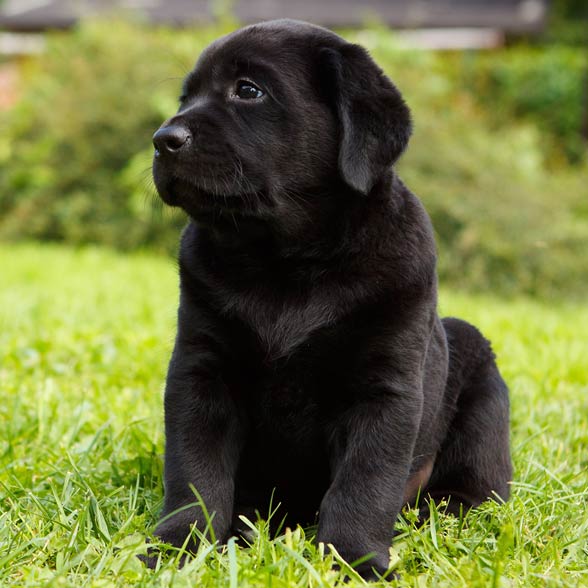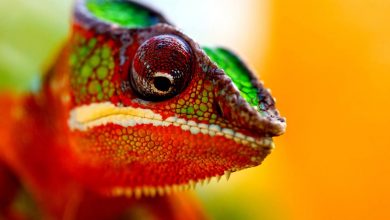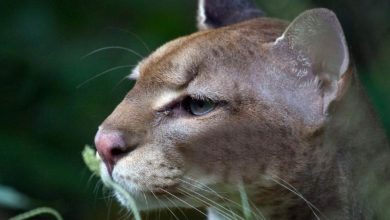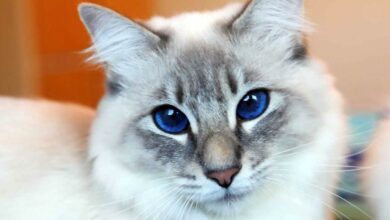Labrador Retriever
We may say it is neither fish nor fowl and there is a bit of truth in it. In fact, Labrador Retriever loves water. Moreover, it has webbed toes, and its tail actually resembles a fin. It is not only lovable and cute, but it is also a real adventurer.
FCI classification
- Group 8: Retrievers, Flushing Dogs, Water Dogs.
- Section 1: Retrievers
- With a working trial

The history of the breed and color varieties
It is said that Labrador Retrievers come from Greenland, where they helped fishermen fishing. They feel great in the water, and they are perfectly adapted for it, thanks to the fin-like tail and waterproof fur. The breed is not that old, though.
The first Club was founded at the beginning of the 20th century (in 1916). The second club, which was devoted to yellow Labrador, was established in 1925. At the end of the 19th century, the dogs were doing great during field trials under the command of the Earl of Malmesbury and the officer P. Hawker. A dog called Malmesbury Tramp is considered the father of all Labradors.
It is assumed that from time to time yellow and chocolate puppies were born but were very often culled. Finally, in the 20th century, those color subtypes were accepted. The first yellow Labrador that was recognized was born in 1899 and was called Ben Hyde. A chocolate subtype was registered in the 1930s.

Yellow subtype and its derivatives
Until the 20th century, yellow Labradors were, in fact, darker than today. This variety was called „golden” until UK Kennel Club changed the requirements concerning the name and the coloration. The Club claimed that this name did not properly indicate this dog’s actual coloration. In the 20th-century people preferred lighter shades, from yellow to cream and it was difficult to find a really dark variety.
However, in 1980 the red and the golden Labradors were brought back to breeding and three dogs of three different color variations were produced. The first one was a dark yellow Labrador called Balrion King Frost. Its children and great grandchildren were fox-red. One of them, Wynfaul Tabasco born in 1986 is called a father of the red variety and was the only one representative of this variety that took part in Show Champion in Great Britain. Other dogs were Red Alert and Scrimshaw Placido Flamingo, which were as well carriers of the gene responsible for red color.

Chocolate subtype
According to the records, chocolate Labradors appeared originally in eight lines. This variety was not considered a separate one until the 20th century.
Moreover, this variety was crossbred with a Flatcoat Retriever and Chesapeake Bay retriever, before the chocolate variety was even recognized. The earl of Feversham and Lady Ward of Chiltonfoliat were breeders of dark Labradors.

Appearance
The breed is quite large. Males weigh from 29 (64 lbs) to 41 kg (90 lbs), and females achieve from 25 (55 lbs) to 32 kg (70 lbs). Specimens that weigh above 46 kg (101 lbs) are considered obese, although there are some exceptions. The breed traits result from the breeding aimed at production of retrievers.
Like in the case of other breeds, the Conformation („English” „Show” or „Bench”) variety differs from the Field („American” or „Working”) even though both lines are bred in both countries. Generally, English Labradors are medium size, have a shorter body, fuller faces and are calmer than the American is. Moreover, it is also higher at shoulders, lighter and has a narrower and longer muzzle. This differentiation is informal and does not exist in the standards provided by American Kennel Club and other breed clubs.
Labradors living in a moderate climate shed their hair twice a year. In other cases, it depends on local weather conditions. However, in general, Labrador’s hair is short and straight, its tail is strong, wider at the base and narrower at the tip. Such tail together with the webbed toes makes it a great swimmer. Moreover, such tail and toes structure help it move easily in the snow. Its fur is thick, short and covered with special oil, which makes it highly resistant to water, even during swimming.
According to kennel clubs’ requirements, black, yellow (from ivory to red fox) and chocolate varieties are allowed to the shows.
Labrador’s head is wide, and it has highlighted eyebrows. Its eyes are medium-size and usually brown or hazelnut. It has a loving and friendly look. Its ears hang close on the head, right above the eyes. Its jaws are strong. Its body is muscular.

Temperament
Labrador is friendly, open and docile. Its keen sense of smell enables it to find a way back home only by tracing a scent. It follows the scents until it finds its source. This skill was found very helpful by the Navy, the police, and other special services. Labradors were used to detect smugglers, thieves, terrorists and contrabandists.
Labradors have an instinct to catch objects with their muzzle, however, they are always very gentle. Moreover, it has a very soft feel to the mouth, which results from being bred to retrieve game such as waterfowl. They tend to chew some objects (however they may be trained not to do it).
Labrador is considered to be balanced and the family dog. It likes children of all ages, as well as other animals.
Lines bred to field work are faster and more athletic than others.

Labradors are quite noisy and love playing, therefore training may be required. It was observed that females are more independent.
Labradors mature at approx. 3 years old, but before reaching adulthood tend to be quite hyperactive.
Before Labradors reach their maturity at the age of three years, they tend to be hyperactive.
They have a lot of enthusiasm, therefore it is recommended that the dog be trained to walk on a leash in order to prevent it from excessive pulling. They love playing balls, sometimes obsessively. They are also very keen on agility competitions, frisbee or flyball.

It barks quite often when it hears a noise, especially when it does not know its source. However, in general, it is quite silent and does not guard a territory that much. It is trustful towards people, therefore it would not make a good guard dog. It loves eating what unfortunately may lead to obesity. The owners should carefully control the amount of food that it eats.
It is perfect for search and rescue, detection, or therapy work. American Kennel Club describes Labradors as great dogs for families and sportsmen. It is also worth remembering that they are skillful hunter dogs.
They do not tend to jump over high fences or dig holes. However, they may like to climb or jump just for pleasure. They need a lot of positive stimulus, however certainly they do not lack motivation.

They are very curious about what is going on around them. They love their owners. They like to learn new scents and objects. They tend to disappear for a while, searching for something new and interesting.
Unfortunately, they are often being kidnapped, as they are naive and too friendly towards strangers. UK Kennel Club proposed that every Labrador should be microchipped. Thanks to the chip, containing an address and the name of the owner, a dog may be easily found.

As a working dog
Thanks to its intelligence and temperament, it is useful in different fields. It often works like the search and rescue dog, in the detection, a therapy work, as an assisting dog or a guide dog. They may also serve as a sled dog. In Canada, they constitute 60% – 70 % of all guide dogs, next to German Shepherds and Golden Retrievers.
It is a great swimmer, and it may adapt to very cold water. It is great as a hunting dog, it observes where a downed fowl falls and looks for it using its sense of smell. Hunters use them very often. Like a hound dog type, it can take a specific standing position (took usually by hunting dogs). It may behave in a way, which is typical for flushing dogs. Just like Leonberger, Newfoundland, and Golden Retriever, it is great for helping people who are drowning.

Health
In comparison to other dog breeds, they are very healthy. However, they still may suffer from genetic diseases such as hip and elbow dysplasia, luxating patella and eye diseases such as progressive retinal atrophy, cataract, corneal dystrophy and retinal dysplasia
They may sometimes have a hereditary myopathy that causes a deficiency in type II muscle fiber, which leads to a short stilted gait or “bunny hopping.” They may as well suffer from autoimmune diseases and deafness. Moreover, they tend to suffer from exercise-induced collapse as well as weakness, collapse, and disorientation.

Obesity
Labradors love to eat, therefore, when they are not active, they may easily get obese. Obesity is the most serious problem concerning dogs. Research shows that at least 25 % of dogs in the US are overweight.
Labradors need to burn the calories. A healthy dog may do the water sprint even for two hours a day. Thanks to that, its body should be in a shape of an hourglass. Overweight may cause hip dysplasia and secondary diseases like for example diabetes. Old, fat dogs very often suffer from osteoarthritis. In order to keep a dog healthy, it should be taken for a walk twice a day for 30 minutes.

Detailed information / size
Labrador Retriever
- Height at shoulders:
- males: 57 – 62 cm (22.5 – 24.5 in)
- females: 54.5 – 59.5 cm (21.5 – 23.5 in)
- Weight:
- dogs: 29 – 41 kg (64 – 90 lb) / according to AKC: 29–36 kg (65–80 lb)
- females: 25 – 32 kg (55 lb – 70 lb)
- Lifespan: 10 – 12 years

Labrador retriever – curiosities
- The breed’s ancestor was St John’s water dog. Those dogs were imported in England and called Labrador as a tribute to the geographic land. The word retriever comes from the verb “retrieve” what indicates that the breed was retrieved on the land next to the Labrador Sea. With time, they were called simply Labradors in order to distinguish them from the larger breed Newfoundland from the Avalon Peninsula in the south. In fact, Labrador Retriever comes from Newfoundland and Newfoundland breed was developed at the same time in Labrador. The names and origins were confused while they appeared in England and the USA. Paradoxically then, Labrador is from Newfoundland and Newfoundland is from Labrador.
- Within the breed there is so-called Australian line, which does not occur in the West, the dogs may be found in Asia, though. They are said to love children very much.
- Within one litter, puppies may have different colors. It is due to the fact that color depends mainly on three genes.
- There are as well so-called silver Labradors, however, this name is unofficial and was created by the breeds’ fans.
- Labrador is so delicate that it can hold an egg in its muzzle and does not crush it.
- Labrador Retrievers are considered one of the most intelligent breeds. They were in 7th place in the ranking of Stanley Coren’s most intelligent dogs in the world.
- High intelligence, empowerment, and independence contribute to great behavior towards people. In 2001 a Labrador called Endal was able to place its unconscious, paralyzed owner in the safe lateral position (she fell off her wheelchair.), covered her with a blanket, took out a phone and started barking to get people’s attention. Finally, he ran to the hotel next to its home to call for help.



















